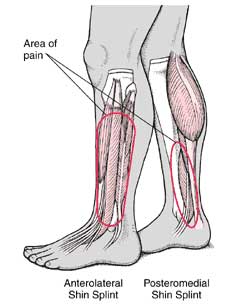Shin Splint Symptoms, Causes, Diagnosis and Treatment

What Is Shin Splint?
The shin splint is defined as the tibia (shinbone) pain. It is the large bone present in your lower leg front. Medically, it is named as a MTSS (Medial Tibial Stress Syndrome), it often occurs in sportspersons who recently have changed or intensified their training routines. The tendons, muscles as well as bone tissue become overworked by the intense activity.
Most shin splints cases are usually treated with rest, care, ice along with other self-care actions. Trying appropriate footwear as well as modifying your routine of exercise can prevent reoccurrence of the shin splints.
What Are The Symptoms Of Shin Splints?
If a person is suffering from shin splints, he may observe:
- Pain, Soreness or Tenderness or along with the inner lower leg part.
- Minor lower leg swelling.
Initially, the pain subsides when you quit exercising or running. In the long run, though, the pain might become continuous.
If the above mentioned self-care techniques won’t relive your pain than it is very important to visit your doctor.
What Are The Causes Of Shin Splints?
Shin splints are due to repetitive condition of stress on the tibia with the connective tissues that attach muscles and bone together.
What Are The Risk Factors Of Shin Splints?
The shin splints risks are more if:
- A person is a runner.
- A person plays hard sports regularly with sudden starts and stops.
- A person runs on rough terrain like hills.
- A person is a member of military training.
- A person has high arches or flat feet.
How Shin Splints Is Diagnosed?
Usually, Shin splints are identified according to the patient’s medical history and a physical examination. In several situations, an imaging technique X-ray or other can identify several possible pain causes, for instance a stress fracture.
How Is Shin Split Treatment?
Usually shin split is treated with simple self-care methods, such as:
- Rest: it is foremost to avoid such activities that can trigger pain, discomfort or swelling but, do not give up all the activities. During the process of healing, try easy exercises, for example bicycling, swimming as well as water running.
- Ice applied to the affected area: ice can cure it too. Apply packs of Ice to the affected area for around 20 minutes, 4 to 8 times in a day for days. But do wrap the ice before applying it to your skin. Direct exposure is dangerous.
- OTC products to relieve pain: different OTC drugs such as
- Motrin, Advil and IB (ibuprofen),
- Aleve (Naproxen sodium) or,
- Tylenol (Acetaminophen) to decrease pain.
Gradually, start doing your daily activities after healing but during treatment, it may worsen your case.
How Shin Splint Is Prevented?
You can prevent shin splints by the following measures:
- Selection of the appropriate shoes for walking
- The arch supports can prevent the pain so select proper arch supports.
- Reduce the impact.
By : Natural Health News




